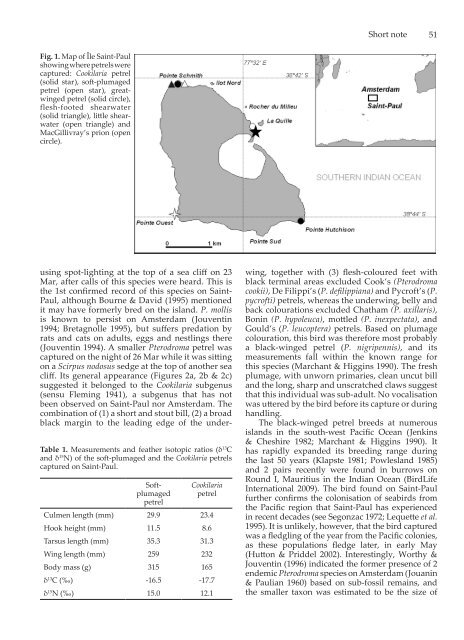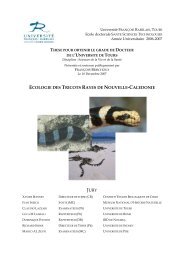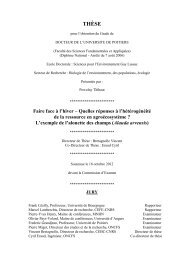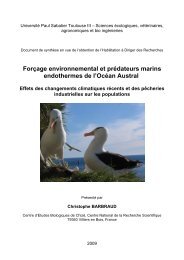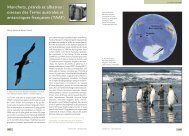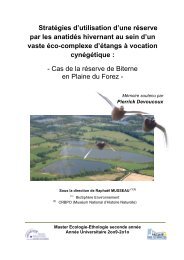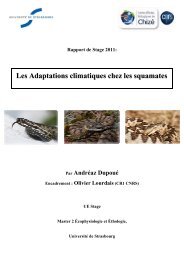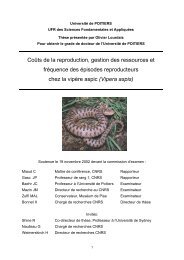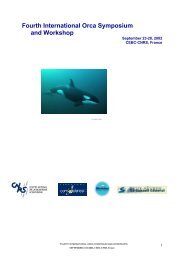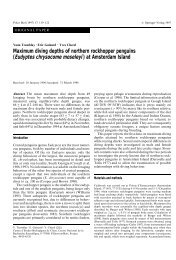SHORT NOTE New petrel records on Île Saint-Paul, southern Indian ...
SHORT NOTE New petrel records on Île Saint-Paul, southern Indian ...
SHORT NOTE New petrel records on Île Saint-Paul, southern Indian ...
You also want an ePaper? Increase the reach of your titles
YUMPU automatically turns print PDFs into web optimized ePapers that Google loves.
Fig. 1. Map of <strong>Île</strong> <strong>Saint</strong>-<strong>Paul</strong><br />
showing where <str<strong>on</strong>g>petrel</str<strong>on</strong>g>s were<br />
captured: Cookilaria <str<strong>on</strong>g>petrel</str<strong>on</strong>g><br />
(solid star), soft-plumaged<br />
<str<strong>on</strong>g>petrel</str<strong>on</strong>g> (open star), greatwinged<br />
<str<strong>on</strong>g>petrel</str<strong>on</strong>g> (solid circle),<br />
flesh-footed shearwater<br />
(solid triangle), little shearwater<br />
(open triangle) and<br />
MacGillivray’s pri<strong>on</strong> (open<br />
circle).<br />
using spot-lighting at the top of a sea cliff <strong>on</strong> 23<br />
Mar, after calls of this species were heard. This is<br />
the 1st c<strong>on</strong>firmed record of this species <strong>on</strong> <strong>Saint</strong>-<br />
<strong>Paul</strong>, although Bourne & David (1995) menti<strong>on</strong>ed<br />
it may have formerly bred <strong>on</strong> the island. P. mollis<br />
is known to persist <strong>on</strong> Amsterdam (Jouventin<br />
1994; Bretagnolle 1995), but suffers predati<strong>on</strong> by<br />
rats and cats <strong>on</strong> adults, eggs and nestlings there<br />
(Jouventin 1994). A smaller Pterodroma <str<strong>on</strong>g>petrel</str<strong>on</strong>g> was<br />
captured <strong>on</strong> the night of 26 Mar while it was sitting<br />
<strong>on</strong> a Scirpus nodosus sedge at the top of another sea<br />
cliff. Its general appearance (Figures 2a, 2b & 2c)<br />
suggested it bel<strong>on</strong>ged to the Cookilaria subgenus<br />
(sensu Fleming 1941), a subgenus that has not<br />
been observed <strong>on</strong> <strong>Saint</strong>-<strong>Paul</strong> nor Amsterdam. The<br />
combinati<strong>on</strong> of (1) a short and stout bill, (2) a broad<br />
black margin to the leading edge of the under-<br />
Table 1. Measurements and feather isotopic ratios (δ 13 C<br />
and δ 15 N) of the soft-plumaged and the Cookilaria <str<strong>on</strong>g>petrel</str<strong>on</strong>g>s<br />
captured <strong>on</strong> <strong>Saint</strong>-<strong>Paul</strong>.<br />
Softplumaged<br />
<str<strong>on</strong>g>petrel</str<strong>on</strong>g><br />
Cookilaria<br />
<str<strong>on</strong>g>petrel</str<strong>on</strong>g><br />
Culmen length (mm) 29.9 23.4<br />
hook height (mm) 11.5 8.6<br />
Tarsus length (mm) 35.3 31.3<br />
Wing length (mm) 259 232<br />
Body mass (g) 315 165<br />
δ 13 C (‰) -16.5 -17.7<br />
δ 15 N (‰) 15.0 12.1<br />
Short note<br />
51<br />
wing, together with (3) flesh-coloured feet with<br />
black terminal areas excluded Cook’s (Pterodroma<br />
cookii), De Filippi’s (P. defilippiana) and Pycroft’s (P.<br />
pycrofti) <str<strong>on</strong>g>petrel</str<strong>on</strong>g>s, whereas the underwing, belly and<br />
back colourati<strong>on</strong>s excluded Chatham (P. axillaris),<br />
B<strong>on</strong>in (P. hypoleuca), mottled (P. inexpectata), and<br />
Gould’s (P. leucoptera) <str<strong>on</strong>g>petrel</str<strong>on</strong>g>s. Based <strong>on</strong> plumage<br />
colourati<strong>on</strong>, this bird was therefore most probably<br />
a black-winged <str<strong>on</strong>g>petrel</str<strong>on</strong>g> (P. nigripennis), and its<br />
measurements fall within the known range for<br />
this species (Marchant & higgins 1990). The fresh<br />
plumage, with unworn primaries, clean uncut bill<br />
and the l<strong>on</strong>g, sharp and unscratched claws suggest<br />
that this individual was sub-adult. No vocalisati<strong>on</strong><br />
was uttered by the bird before its capture or during<br />
handling.<br />
The black-winged <str<strong>on</strong>g>petrel</str<strong>on</strong>g> breeds at numerous<br />
islands in the south-west Pacific Ocean (Jenkins<br />
& Cheshire 1982; Marchant & higgins 1990). It<br />
has rapidly expanded its breeding range during<br />
the last 50 years (Klapste 1981; Powlesland 1985)<br />
and 2 pairs recently were found in burrows <strong>on</strong><br />
round I, Mauritius in the <strong>Indian</strong> Ocean (Birdlife<br />
Internati<strong>on</strong>al 2009). The bird found <strong>on</strong> <strong>Saint</strong>-<strong>Paul</strong><br />
further c<strong>on</strong>firms the col<strong>on</strong>isati<strong>on</strong> of seabirds from<br />
the Pacific regi<strong>on</strong> that <strong>Saint</strong>-<strong>Paul</strong> has experienced<br />
in recent decades (see Seg<strong>on</strong>zac 1972; lequette et al.<br />
1995). It is unlikely, however, that the bird captured<br />
was a fledgling of the year from the Pacific col<strong>on</strong>ies,<br />
as these populati<strong>on</strong>s fledge later, in early May<br />
(hutt<strong>on</strong> & Priddel 2002). Interestingly, Worthy &<br />
Jouventin (1996) indicated the former presence of 2<br />
endemic Pterodroma species <strong>on</strong> Amsterdam (Jouanin<br />
& <strong>Paul</strong>ian 1960) based <strong>on</strong> sub-fossil remains, and<br />
the smaller tax<strong>on</strong> was estimated to be the size of


